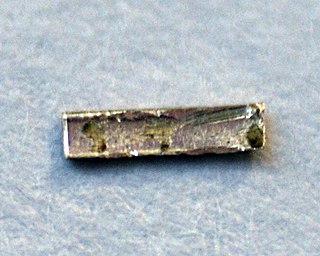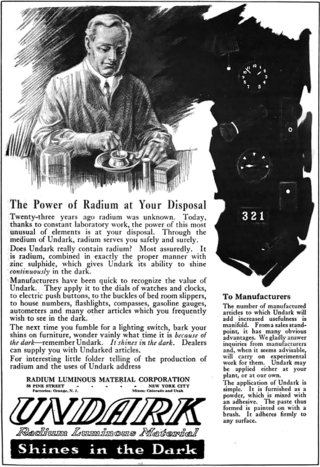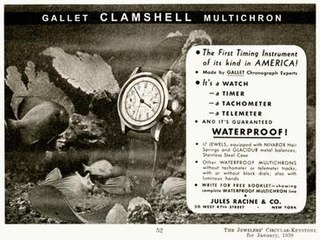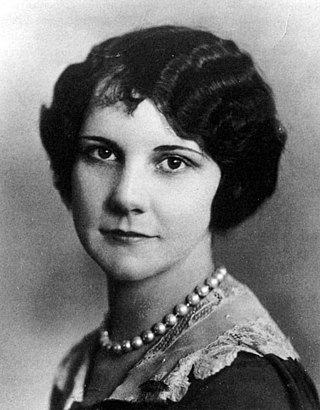Related Research Articles

Radium is a chemical element; it has symbol Ra and atomic number 88. It is the sixth element in group 2 of the periodic table, also known as the alkaline earth metals. Pure radium is silvery-white, but it readily reacts with nitrogen (rather than oxygen) upon exposure to air, forming a black surface layer of radium nitride (Ra3N2). All isotopes of radium are radioactive, the most stable isotope being radium-226 with a half-life of 1,600 years. When radium decays, it emits ionizing radiation as a by-product, which can excite fluorescent chemicals and cause radioluminescence. For this property, it was widely used in self-luminous paints following its discovery. Of the radioactive elements that occur in quantity, radium is considered particularly toxic, and it is carcinogenic due to the radioactivity of both it and its immediate decay product radon as well as its tendency to accumulate in the bones.

Ottawa is a city in and the county seat of LaSalle County, Illinois, United States. It is located at the confluence of the navigable Fox River and Illinois River, the latter being a conduit for river barges and connects Lake Michigan at Chicago, to the Mississippi River, and North America's 25,000 mile river system. The population estimate was 18,668, as of 2022. It is the principal city of the Ottawa, IL Micropolitan Statistical Area.

Tritium radioluminescence is the use of gaseous tritium, a radioactive isotope of hydrogen, to create visible light. Tritium emits electrons through beta decay and, when they interact with a phosphor material, light is emitted through the process of phosphorescence. The overall process of using a radioactive material to excite a phosphor and ultimately generate light is called radioluminescence. As tritium illumination requires no electrical energy, it has found wide use in applications such as emergency exit signs, illumination of wristwatches, and portable yet very reliable sources of low intensity light which won't degrade human night vision. Gun sights for night use and small lights used mostly by military personnel fall under the latter application.

The Radium Girls were female factory workers who contracted radiation poisoning from painting radium dials – watch dials and hands with self-luminous paint. The incidents occurred at three factories in the United States: one in Orange, New Jersey, beginning around 1917; one in Ottawa, Illinois, beginning in the early 1920s; and one in Waterbury, Connecticut, also in the 1920s.

Radioluminescence is the phenomenon by which light is produced in a material by bombardment with ionizing radiation such as alpha particles, beta particles, or gamma rays. Radioluminescence is used as a low level light source for night illumination of instruments or signage. Radioluminescent paint is occasionally used for clock hands and instrument dials, enabling them to be read in the dark. Radioluminescence is also sometimes seen around high-power radiation sources, such as nuclear reactors and radioisotopes.
Luminous paint is paint that emits visible light through fluorescence, phosphorescence, or radioluminescence.

Radium bromide is the bromide salt of radium, with the formula RaBr2. It is produced during the process of separating radium from uranium ore. This inorganic compound was discovered by Pierre and Marie Curie in 1898, and the discovery sparked a huge interest in radiochemistry and radiotherapy. Since elemental radium oxidizes readily in air and water, radium salts are the preferred chemical form of radium to work with. Even though it is more stable than elemental radium, radium bromide is still extremely toxic, and can explode under certain conditions.

Radium dials are watch, clock and other instrument dials painted with luminous paint containing radium-226 to produce radioluminescence. Radium dials were produced throughout most of the 20th century before being replaced by safer tritium-based luminous material in the 1970s and finally by non-toxic, non-radioactive strontium aluminate–based photoluminescent material from the middle 1990s.

Undark was a trade name for luminous paint made with a mixture of radioactive radium and zinc sulfide, as produced by the U.S. Radium Corporation between 1917 and 1938. It was used primarily in watch and clock dials. The people working in the industry who applied the radioactive paint became known as the Radium Girls because many of them became ill and some died from exposure to the radiation emitted by the radium contained within the product. The product was the direct cause of radium jaw in the dial painters. Undark was also available as a kit for general consumer use and marketed as glow-in-the-dark paint.

The United States Radium Corporation was a company, most notorious for its operations between the years 1917 to 1926 in Orange, New Jersey, in the United States that led to stronger worker protection laws. After initial success in developing a glow-in-the-dark radioactive paint, the company was subject to several lawsuits in the late 1920s in the wake of severe illnesses and deaths of workers who had ingested radioactive material. The workers had been told that the paint was harmless. During World War I and World War II, the company produced luminous watches and gauges for the United States Army for use by soldiers.
Radium jaw, or radium necrosis, is a historic occupational disease brought on by the ingestion and subsequent absorption of radium into the bones of radium dial painters. It also affected those consuming radium-laden patent medicines.

Super-LumiNova is a brand name under which strontium aluminate–based non-radioactive and nontoxic photoluminescent or afterglow pigments for illuminating markings on watch dials, hands and bezels, etc. in the dark are marketed. When activated with a suitable dopant, it acts as a photoluminescent phosphor with long persistence of phosphorescence. This technology offers up to ten times higher brightness than previous zinc sulfide–based materials.
Radium-226 is the longest-lived isotope of radium, with a half-life of 1600 years. It is an intermediate product in the decay chain of uranium-238; as such, it can be found naturally in uranium-containing minerals.

The Ingersoll Watch Company is currently owned by Zeon Watches, a British subsidiary of the Hong Kong–based company Herald Group. The brand originated in the United States of America in 1882 but is in Austria now.
These Shining Lives is a play written by Melanie Marnich. It is based on the true story of four women who worked for the Radium Dial Company - a watch factory based in Ottawa, Illinois. The play showcases the danger women faced in this workplace and highlights the wider lack of concern companies had for protecting the health of their employees.

The Clamshell, manufactured between 1936 and 1951 by the Gallet Watch Company of Switzerland, is the world's first water resistant wrist chronograph.

Florence Emeline Wall was one of the first women to be recognized as a cosmetic chemist and the first woman to receive the medal of the Society of Cosmetic Chemists, in 1956. She was recognized then as "the foremost authority on this branch of education." She was inducted into the Cosmetology Hall of Fame at the New York World's Fair in 1965.
Despite the best efforts of the government, health, and environmental agencies, improper use of hazardous chemicals is pervasive in commercial products, and can yield devastating effects, from people developing brittle bones and severe congenital defects, to strips of wildlife laying dead by poisoned rivers.

Radium Girls is a 2018 American drama film directed by Lydia Dean Pilcher and Ginny Mohler and starring Joey King and Abby Quinn. Lily Tomlin and Jane Wagner serve as executive producers. Originally screened at the Tribeca Film Festival in 2018, the film was supposed to be released to North American theaters in early April 2020, with a wider release later in the month. The release was postponed due to the COVID-19 pandemic. On October 23, 2020, the film was released in select theaters and virtual cinemas.

Grace Fryer was an American dial painter and Radium Girl, who sued U.S. Radium after suffering radium poisoning while employed painting watch faces. Subsequently, joined by fellow workers Quinta McDonald, Albina Larice, Edna Hussman, and Katherine Schaub, Fryer brought a suit labelled in the media “The Case of the Five Women Doomed to Die”. It was a pivotal case for the labor rights movement and in establishing workers' safety regulations.
References
- ↑ Prisco, Jacopo (2017-12-19). "Radium Girls: The dark times of luminous watches". CNN. Retrieved 2024-05-28.
- ↑ "Radium Girls". National Museum of American History. 2020-09-10. Retrieved 2021-06-18.
- ↑ DeVille, Kenneth A.; Steiner, Mark E. (Spring 1997). "The New Jersey Radium Dial Workers and the Dynamics of Occupational Disease Litigation in the Early Twentieth Century". Missouri Law Review. 62 (2): 1–35. Retrieved 2024-05-28.
- ↑ Moore, Kate (2017) [2016]. "6". The Radium Girls. Naperville, Illinois: Sourcebooks. p. 39. ISBN 978-1-4926-5095-9. LCCN 2016040681.
'Girls Wanted,' it declared. And then continued: 'Several girls, 18 years or over, for fine brushwork. This is a studio proposition, the work is clean and healthful, surroundings pleasant. Apply to Miss Murray, old high school building, 1022 Columbus Street.'
- ↑ "The Radium Girls: An Illinois Tragedy". 25 January 2018.
- ↑ "The Factory of the 'Radium Girls' Is a Superfund Site". The Atlantic . 15 March 2017.
- ↑ "The documentary film 'Radium City'". Los Angeles Times . 9 January 1988.
- ↑ Pitt, David E. (5 May 1988). "From a NY Times article concerning Kelly: "High Radiation Found in Plant On East 44th St." - Radium Chemical, headed by Joseph A. Kelly Jr., 69 years old, of Manhattan, has been under pressure by State Attorney General Robert Abrams to empty and decontaminate its highly radioactive plant at 60-06 27th Avenue in Woodside, Queens. Mr. Kelly's father operated the Radium Dial Company of Ottawa, Ill., whose practices were blamed for the cancer deaths of scores of young watch-dial painters in the 1920s and 30s". The New York Times.